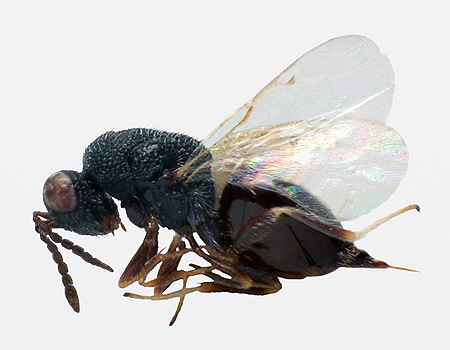Pests
Bruchophagus roddi Gussakovsky - Alfalfa Seed Chalcid
Systematic position.
Class Insecta, order Hymenoptera, superfamily Chalcidoidea, family Eurytomidae, genus Bruchophagus Ashmead. Closely related to Bruchophagus gibbus Boh. and и B. platypterus Walk. (B. kolobovae Fed.).Biological group.
Pest of seed alfalfa.Morphology and biology.
Body black; fore-tibia, knee, and tarsus yellowish. Head and thorax covered with short and sparse pubescence. Head slightly wider than pronotum; genae slightly shorter than longitudinal eye diameter. Antennae protrude from the middle of face; clava 3-segmented, wider than funicle; female funicle 5-segmented, male's is 4-segmented. Funicular segments slightly elongated in female. Each of male funicular segments narrowed toward base and apex. Thorax weakly convex, pronotum approximately 3 times wider than length and slightly shorter than mesonotum. Integument of head and thorax with surface reticulation. Propodeum flattened, without median groove, with finely punctated central area. Wings are transparent, venation yellowish-brown in color. Postmarginal vein on forewings slightly longer than radial and marginal veins. Female abdomen shorter than thorax, ovate, pointed toward apex, and weakly elevated in apical part. Petiole transversal. Ovipositor weakly prominent beyond abdomen. Body length 1.3-1.8 mm in female, 1.2-1.7 mm in male. Larva of last instar hibernates inside alfalfa seed. Diapause of some larvae lasts up to 3 years. Up to 35% of population die off during hibernation. Larva pupates inside the seed from the end of April; adults fly from the middle of May until the end of June. Males start to fly earlier. Later, the number of females increases, and at the end of summer, only females are present. Pairing begins immediately or 2-3 days after emergence of females. Fertility is about 65 eggs. Egg ovate, shiny, white, with long and short pedicels. Alfalfa pods that are 8-9 days old are more attractive for oviposition. Longevity of adults in laboratory is about 21 days.Distribution.
The species is distributed in Europe, the Middle East, India, North America, Australia, and New Zealand. It inhabits the European part of the former USSR north to Karelia, the Caucasus, West and East Siberia, the Far East, Middle Asia, and Kazakhstan.Ecology.
Medicago sativa and M. falcata are the main host plants of the Alfalfa Seed Chalcid. Moreover, it develops on Medicago glandulosa, M. lupulina, and Alhagi camelorum. Adults. emergence usually coincides with the beginning of alfalfa flowering. In the middle belt of the European part of the former USSR, the species is bivoltine, producing 3 generations in the South and 3-5 in Middle Asia and southern Kazakhstan. The generations often overlap. The adult specients occur in Kazakhstan until the beginning of September. Adults fly in the morning and daytime at air temperatures of about 25-27°C, and in the morning and evening with higher temperatures. Tetrastichus bruchophagii Gah., Habrocytus medicaginis Gah., Eutelus bruchophagii Gah., and Liodontomerus perplexus Gah. are parasites of larvae of the Alfalfa Seed Chalcid.Economic significance.
The pest causes damage during its larval stage. Yield losses of alfalfa seeds sometimes reach 80%. The first hay-crop of alfalfa is preferable for seed growing. Control measures include using fertilizers, sowing new fields of alfalfa at a distance of more than 7 km from old alfalfa fields, deep autumn plowing, removal of infected seeds from alfalfa seed harvest and utilization of the latter before the next spring. Alfalfa growing in crop rotation is not desirable for 2-3 years or more. Pesticide treatment against the Alfalfa Seed Chalcid is necessary during the evening time, when most bees retire from fields. Chemicals with a low toxic level to honeybees are used as pesticides.Related references:
Antonova, V.P. & Tertyak, K.D. 1978. Biological foundation of the time pesticide treatment against alfalfa seed chalcid. In: Rud', G.Ya., ed. Agricultural plant protection from pests and diseases (Interdepartmental collection of works). Kishinev: SKhI, 32-37. (in Russian).Kolobova A.N. 1950. Clover and alfalfa biological race of the Bruchophagus gibbus Boh. (Hymenoptera, Eurytomidae). Entomol. obozr. 31(1-2): 63-70 (in Russian)
Lakhmanov, V., Zubkov, V. 1981. Biology of lucerne-seed chalcid, its harmfulnesss and control in Tzelinograd Region. Proceeding of Siberian department of VASKHNIL (Novosibirsk) 6: 33-37 (in Russian).
Mel'nichuk, A.I. 1982. Control measures against alfalfa seed chalcid. Bulletin of agricultural science of Kazakhstan (Alma-Ata) 4: 41-42 (in Russian).
Nikol'skaya, M.N. 1952. On the fauna of Chalcidoidea of the USSR. Moscow-Leningrad: AN USSR, 575 p. (in Russian).
Shchegolev, V.N., ed. 1955. Agricultural Entomology. Leningrad & Moscow: Sel.khozgiz, 616 p. (in Russian).
Vasil'ev, V.P., ed. 1974. Pests of agricultural crops and forest plantations. V. 4. Kiev: Urozhai, 606 p. (in Russian).
Zerova, M.D. 1978. Family Eurytomidae. In: Medvedev, G.S., ed. Keys to the insects of the European part of the USSR. V. 3(2). Leningrad: Nauka, p. 328-350 (in Russian).
Zerova, M.D. 1983. Family Eurytomidae. In :Kopaneva, L.M., ed. Keys to harmful and useful insects and mites on the annual and perennial grasses and leguminous plants in the USSR. Leningrad: Kolos, p. 181-187 (in Russian).
Zerova, M.D. 1995. Family Eurytomidae. In: Ler, P.A., ed. Keys to the insects of the Russian Far East. V. 4(2). Vladivostok: Dal.nauka, p. 257-286. (in Russian).
Zerova, M.D., Seregina, L.Ya. 1994. Seed-eating Chalcidoidea of Palaearctics. Kiev: Naukova Dumka, 236 p. (in Russian).


